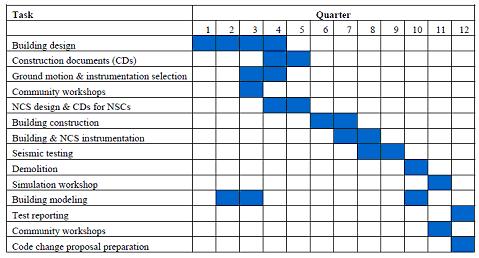|
Before any of the results from the project can be obtained, it will of course be necessary to successfully build the structure and outfit it with a set of non-structural components and systems. The design and management of the production system to construct the building will have important implications for the performance, cost-effectiveness, and safety of the tests to be conducted. As a result, management, the construction management phase is an important component of the project.
The construction portion of this project also provides an opportunity for mentoring and education in construction engineering. Therefore, the project will rely on graduate and undergraduate students from the J.R. Filanc Construction Engineering and Management Program at San Diego State University to serve in a construction management capacity. This will include constructability reviews during design, coordinating scope review and assisting in contractor select, as well as managing the construction process itself. An industry mentor will be recruited to serve as the owner's representative during the construction phase. The mentor will work with proejct faculty to mentor graduate and undergraduate students. Working together, they will oversee construction progress, approve progress pay requests, provide periodic progress reports, and provide daily reporting. An approximate schedule for the project is shown in the Figure.
 Fig. 1 Approximate Construction Schedule of the Project
Fig. 1 Approximate Construction Schedule of the Project
Because of the site restrictions, the small footprint of the building, and donated work content, special attention to coordination, procurement, and constructability will be critical. A key concern is the identification of scope gaps. When gaps are identified, the project team will work to close them with donated work by coordinating relevant “subcontract” work packages, or identify funding needs as a last resort. The construction management team (investigators, mentor, and students) will facilitate by circulating construction documents for both the in-kind work and paid work among the project team. A general contractor will be selected during design, to inform the design with construction process knowledge. At least one constructability review workshop will be held with critical path and high-value trade contractors as the design nears completion.
In addition to the educational opportunities afforded to the students directly involved in the project, the experience will be used to produce construction engineering educational content. During construction, detailed observations of construction processes will be made to provide materials for classroom use regarding construction productivity, construction methods, or process capability projects, in furtherance of educational objectives for the project. Furthermore, data will be collected to populate building information modeling (BIM) of the structure for use in college classes and in modules to be deployed at Kearny High School’s Construction Technical Academy (CTA) Construction progress tracking will also be conducted at a high level of detail to facilitate research into construction production processes. It is hoped that these efforts can lead to more fundamental understanding of work sequencing and queuing in construction. With graduate students involved in the construction management, high levels of detail to support validation and extension of these production models can be captured.
|